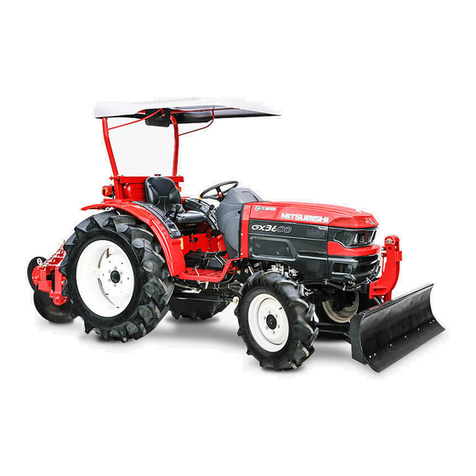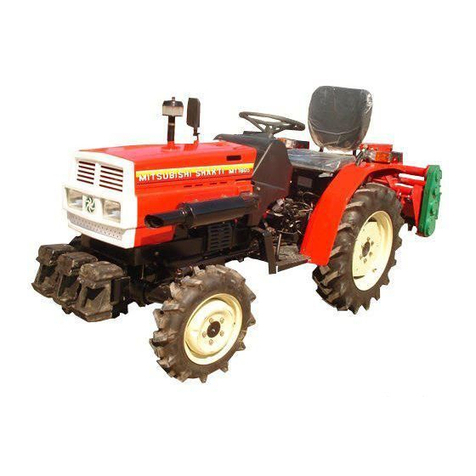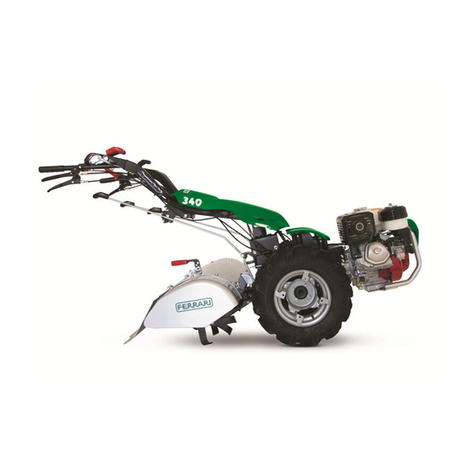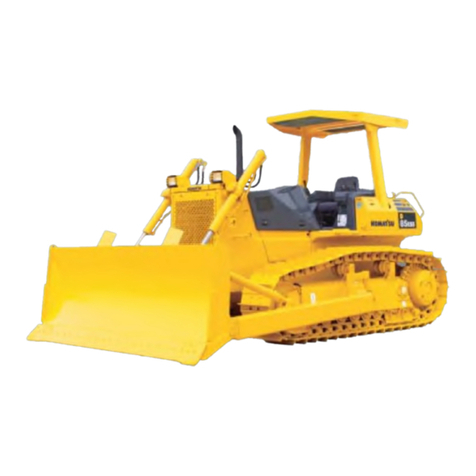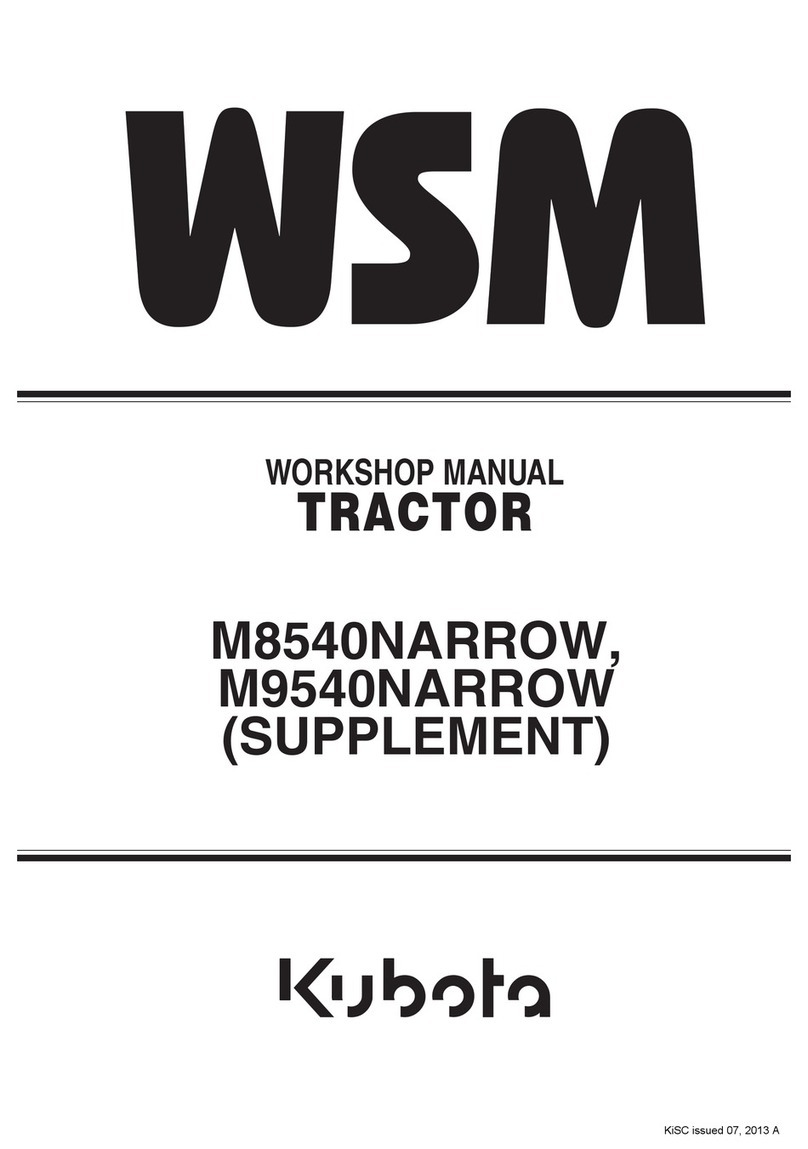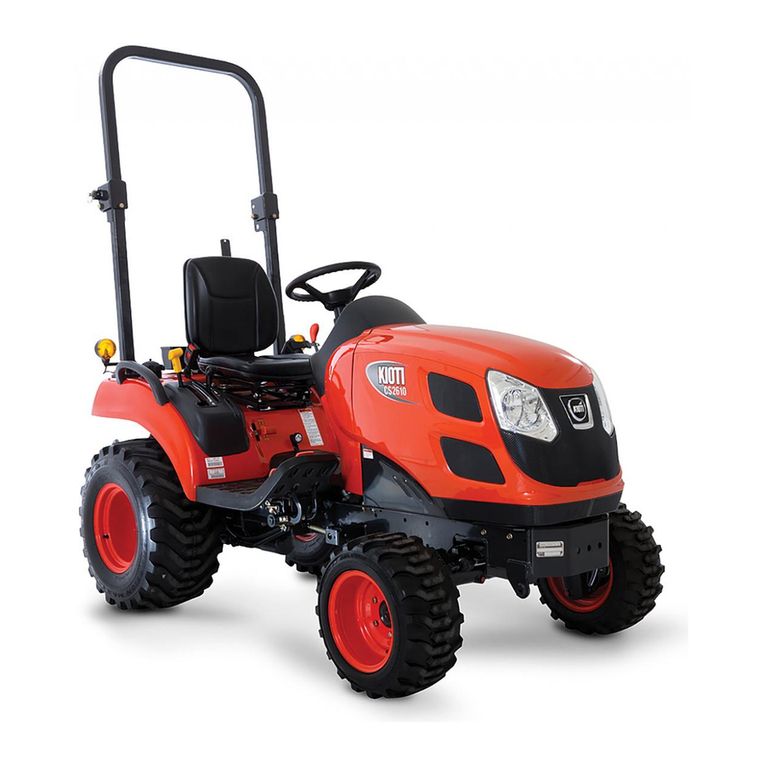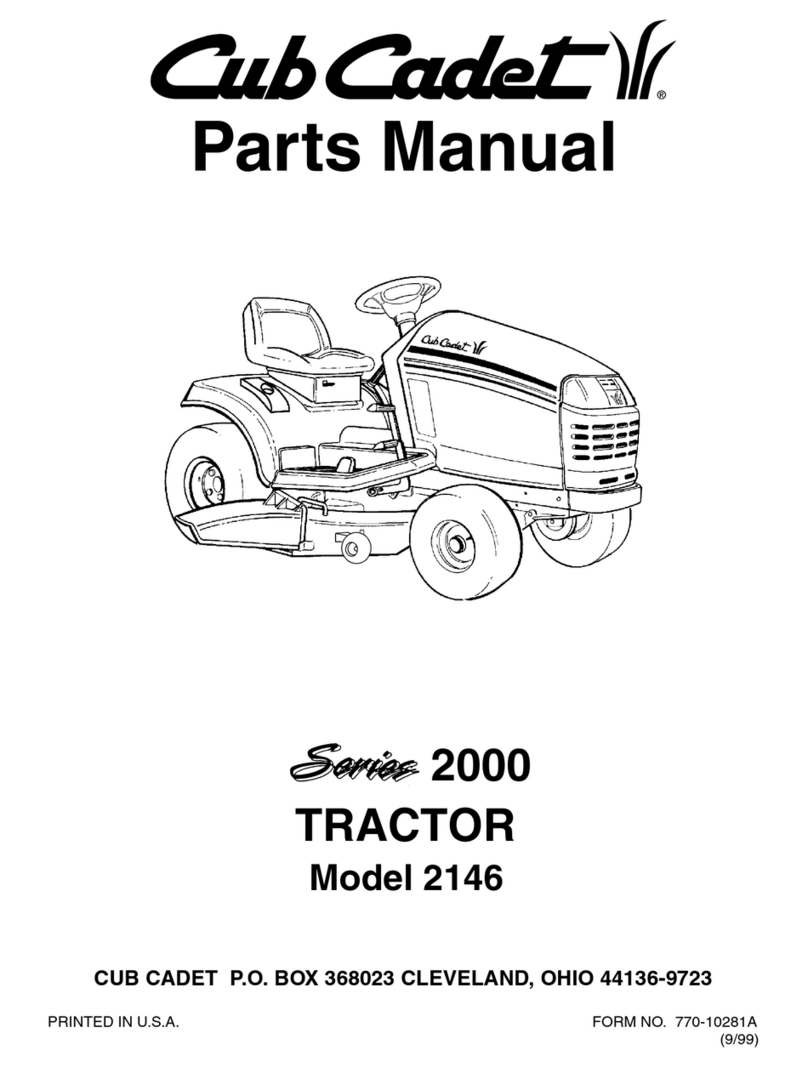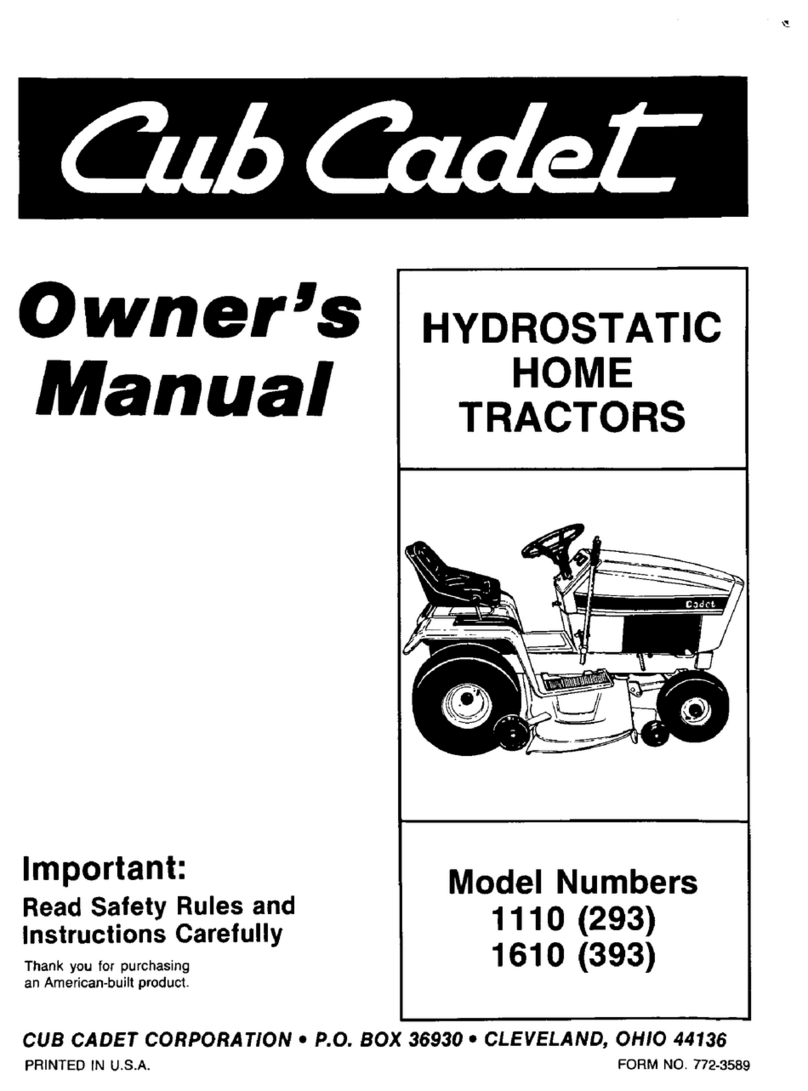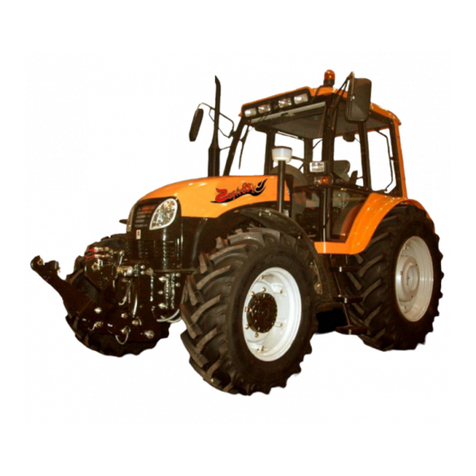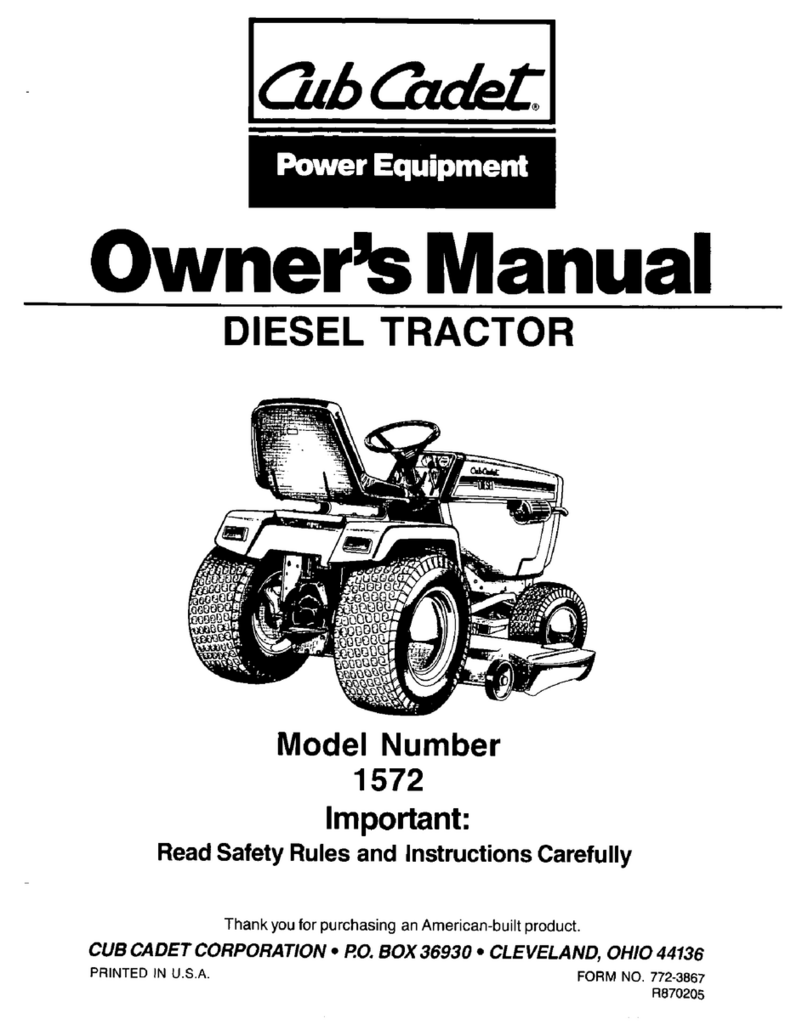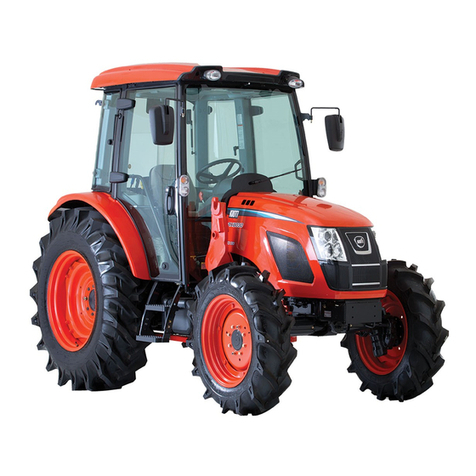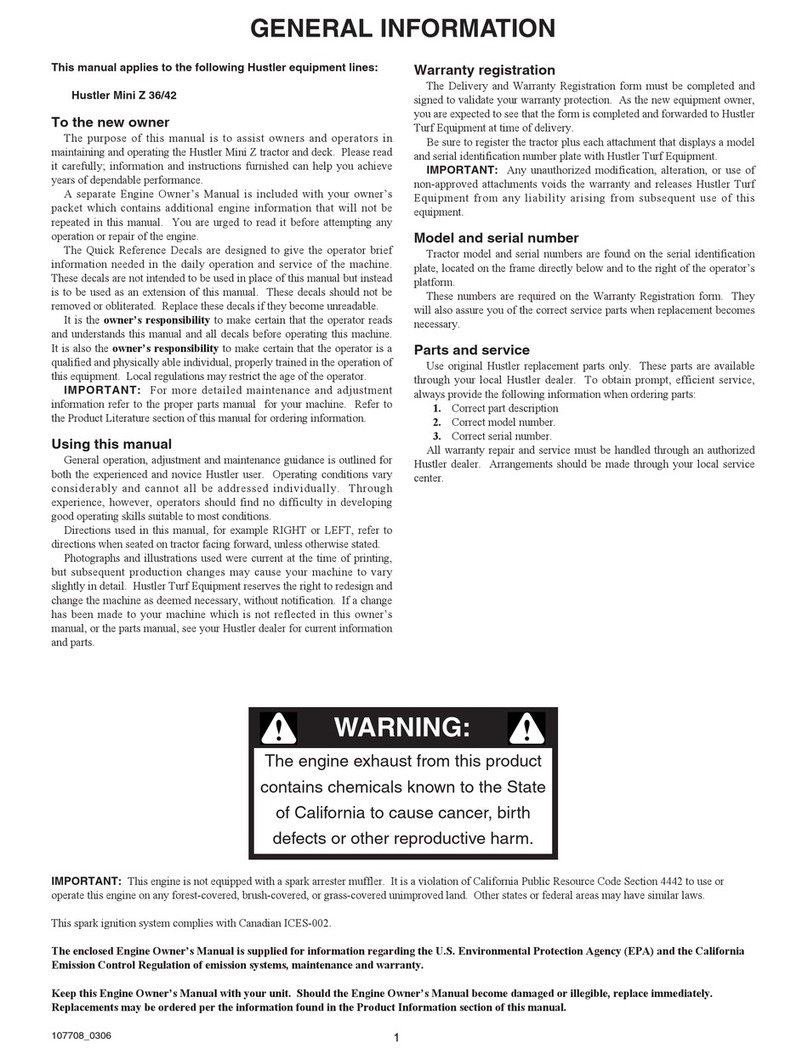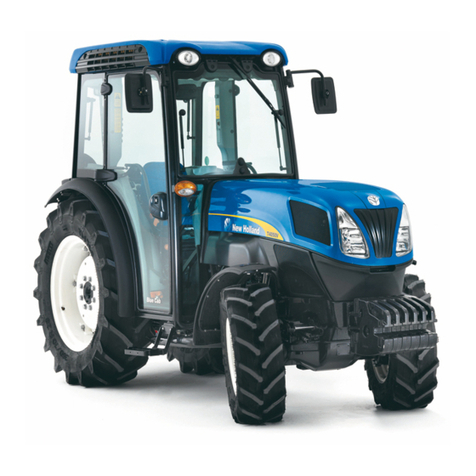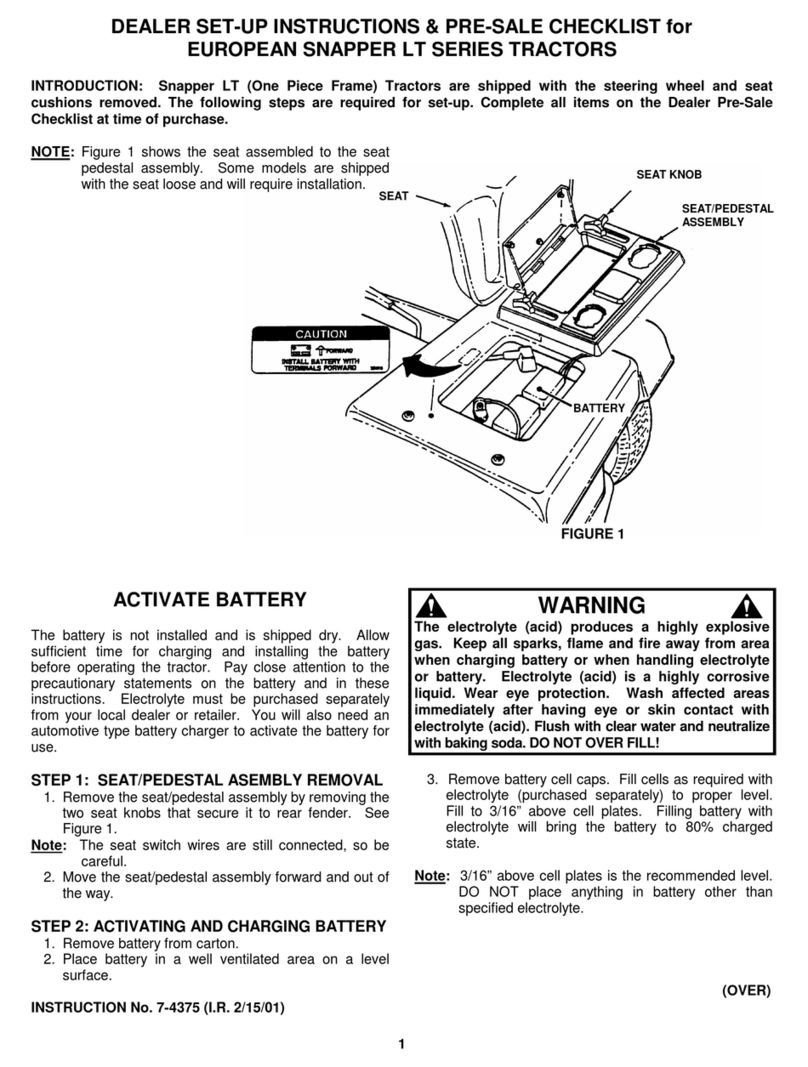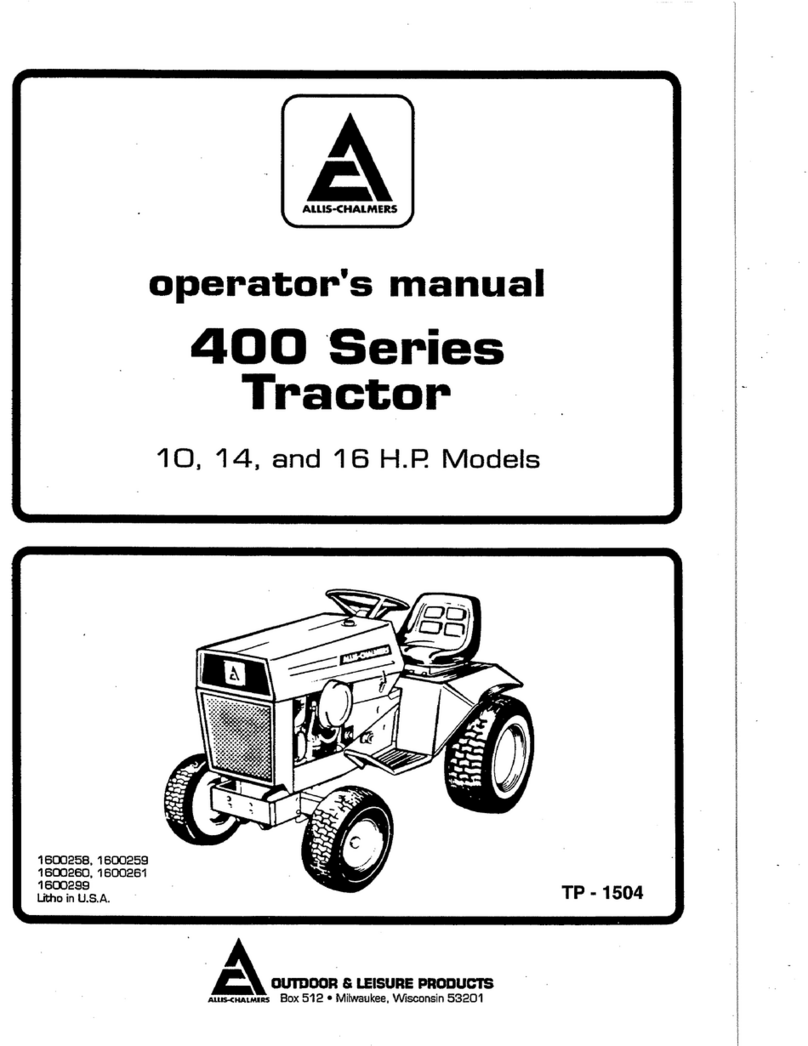Mitsubishi 1540 FD User manual

Mitsubishi
Agricultural Machinery Corporation
Owners Manual
Mitsubishi 1540 FD

Any improper handling of this tractor could lead to an accident Prior to the
operation of the tractor, be sure to read the Instruction Manual carefully
and have a thorough understanding of the description In particular, the
instructions given in “Safety Precautions” must be strictly followed
SAFETY PRECAUTION
•When running the tractor at high speed or on roads, make sure the right and left brake pedals
are interlocked so that they will not be operated independently
•Make sure that a guard is in place when operating the belt pully or PTO driven shaft
•Always wear relatively tight and belted clothing when operating the tractor Loose jackets,
shirts, sleeves or other loose clothing should not be worn because of the danger of catching
them in moving parts, engine or implement
•When leaving the tractor, be sure to stop the engine, applying the parking brake and pulling out
the starting key
•Never make sharp turns at high speeds
•When descending a slope in reverse, be sure not to abruptly operate the clutch or the brake
•Never operate the differential lock when running on a public road
•When making a sharp turn, confirm that the differential lock is disengaged
•Never operate the tractor on a slope that seems to be dangerous Do not operate the clutch,
brake, throttle lever and steering wheel abruptly on a slope as it is dangerous Be careful
particularly when running on a slippery road
•DO not carry any passengers on the tractor, nor on the linkage drawbars and implements
•When towing, set the hitch point below the center line of the rear axle
•When refueling, be sure to stop the engine Also take special care so that the fuel will not catch
fire
•Use a safe fuel container Fill the tank outdoors and wipe up spilled fuel Replace the fuel cap
securely
•Never touch engine parts after operating the tractor or the engine until parts have had
sufficient time to cool
•Always keep positive battery post covered with the rubber boot on the end of the cable
•Never operate the tractor engine in a closed building where carbon monoxide fumes can collect
•Do not allow Children to operate the tractor, nor adults to operate it without proper instruction
•When mounting an implement on the tractor, be sure to follow the instructions given in “Safety
Precautions” in the implement Operation Manual
•When running the 4-WD tractor on roads, be sure to place the front drive shift lever in OFF

Introduction
This instruction manual contains information on the operation,
lubrication and maintenance of your tractor The information
contained is comprehensive and essential, and is designed to assist
you, even if un-experienced, in utilizing your tractor
How well your tractor continues to give satisfactory performance
depends greatly upon the mannor in which it is operated It is,
therefore, requested that this manual be read carefully and kept
ready for use so that the operation and maintenance services will be
properly be carried out in order to keep the tractor in top mechanical
condition at all times
Should any information as to your tractor be required, consult local
dealer or distributor station the machine and engine serial numbers of
the tractor concerned
We are sure you will be happy with this tractor
Tractor serial number Engine serial number

CONTENTS

Section 1 Operation
Starting and stopping the engine
Before starting the engine, be sure to check the following
points
1. Confirm that the fuel tank is filled with sufficient fuel.
2. Check the amount of oil in the engine and transmission.
3. Check the coolant water level.
4. Always perform the daily maintenance described in S CTION 2
STARTING
On this tractor, the safety starter switch is provided for preventing unforeseen accidents
form breaking out starting the engine. Installed between the starter switch and the starter
motor, the safety starter switch works as a kind of circuit breaker by which, in case the clutch is
not disengaged completely, the electric circuit in the engine starting system is not closed even
when the key is turned to the START position.
1 Set the throttle lever at the center between idling and high speed
2 After applying the parking brake, place the main shift lever and PTO shift lever in
neutral Then fully depress the clutch pedal
3 Insert the starter key into the key switch and turn it counter-clockwise and hold it
at the “Heat” position to heat the glow plugs As soon as the glow plug signal on
the instrument panel glows red, about 30 seconds latter, rapidly turn the key to
the “Start” position and the starter motor will rotate and the engine will start
4 When the engine is started, take your hand off the key and the key then
automatically returns to the “ON” position The key must be in the “On” position
while the engine is running
5 After starting the engine, make sure the battery charge warning lamp, water
temperature warning lamp and engine oil pressure warning lamp are off If any
one of the lamps will not turn off, or lights up, stop the engine immediately, check
the cause and then take the necessary countermeasures
6 If the engine does not start on the first attempt, do not rotate the starter motor
continuously more than 10 second Then heat the glow plug well and restart the
engine
7 Warm up the engine especially in cold weather, before working

STARTING IN COLD W ATH R
1 The fuel injection pump of this engine adopts the mechanism to ensure easier
engine starting by excessive injection of fuel when the throttle lever is fully pulled
2 To start the engine specially in cold weather fully pull the throttle lever, heat the
glow plug enough and crank the engine
Notes:
1. After the engine has started confirm yhat the engine is running smoothly listening carefully to
acertain if nothing abnormal sounds, and inspect for oil and water leakage.
2. In case fuel runs out, be sure to bleed the fuel system after refilling the fuel tank; otherwise the
engine may not be started (or even stopped soon after started). (See S CTION 3. Bleeding the Fuel
system)
Important:
1. Never use ether to start the engine or this tractor.
2. Unless the engine stops, don’t run the starter motor.
STOPPING
After idling the engine for a while by setting the speed control lever at the appropriate position, bring
the throttle lever fully to the “STOP” position, and fuel is then cut off and the engine will stop.
Be sure to turn the starter key “OFF” when the engine has been stopped. When the operator leaves the
tractor, be sure to apply the parking brake and take out the key.
INSTRUM NTS AND CONTROLS
TRACTOR METER
The tractor meter, which reads the engine speed and hours of operation, is mounted on the instrument
panel.
The engine speed meter is in the upper portion which indicates the engine speed in rpm. The hour
meter located in the lower center shows the accumulated running hours at rated engine speed.
OIL PRESSURE WARNING LAMP
When the starter key is switched “ON”, this lamp glows yellow. When oil is circulating normally while
the engine is running, the lamp turns off. If the lamp still glows yellow after the engine has been
started, stop the engine immediately and check the engine lubrication oil level. If that is OK, check the
oil pressure switch and cabling. If thereare any defective switches or cables, replace them.

BATTERY CHARGE WARNING LAMP
When the starter switch is set to “ON” position, the battery charge warning lamp glows red. When the
battery is being charged normally while the engine is running, the lamp turns off. If the lamp continues
to glow, stop the engine and check the alternator, regulator, and cabling. If there is anything defective,
replace it.
WATER TEMPERATURE WARNING LAMP
Under normal operating conditions, the warning lamp will not turn on with the starter key in the “ON”
position. When the coolant temperature rises abnormally, the warning light lights up, indicating
overheating. Check the coolant level and fan belt, and recondition, as required.
CAUTION:
Utmost care should be taken when removing the radiator cap while the engine is overheated.
LIGHT SWITCH
The headlight switch is located on the left side of the instrument panel.
(Photo)
Headlights off
Headlights are on
Headlights are dimmed
NOT :
The switch for the working lamp is incorporated in the light itself.
SAFETY STARTER SWITCH
As mentioned previously in this book, the safety starter switch is provided for preventing unforeseen
accidents while starting the engine. Assembled in the engine starting system between the starter switch
and the starter motor, the safety starter switch works as a circuit breaker in relation to the clutch pedal
operation; unless the clutch pedal is fully depressed to completely interrupt the power to the engine to
the transmission, the safety starter switch remains open, keeping the starter motor circuit to open even
when the starter key is turned to the “START” position.
GLOW PLUG
The engine is fitted with sheathed type glow plugs which preheat the combustion chamber so that the
engine may be started easily even in cold weather.

GLOW SIGNAL
The glow signal which indicates the heating state of the glow plug in the combustion chamber is
installed on the instrument panel. It is easily seen from the heating condition of the glow signal
resistance wire..
THROTTL L V R
When the throttle lever is pulled fully tward the operator, the engine speed reaches the maximum of
2,900 rpm.
The rated speed of the engine model K3B is 2,700 rpm. The engine speed is not theonly the most
appropriate one to get the longest service life from your tractor but also the most economicial one. It is
best therefore, to run the engine at the rate of 2,700 rpm.
FOOT THROTTL
The foot throttle is installed on the right side of the step. When the hand throttle lever is in the idling
position, the engine speed and be controlled freely within the range by depressing the foot pedal.
NOT : When the hand throttle is in a high revolution mode, the foot throttle also moves into the
position for those revs. When this is done the revolutions cannot be controlled by the foot throttle
within the range below the revolutions set by the hand throttle lever.
CLUTCH
Depress the clutch pedal fully to bring the machine to a complete halt when shifting the gear in the
transmission for changing the machine propelling speed. For shifting the PTO gears and shifting the 4-
WD gear follow the similar manner.
Lowering the speed, when the tractor is overloaded, by half engaging the clutch or changing the gear at
high speed will damage the clutch lining. De-clutching must be performed completely, in one clean
quick movement with the engine revolutions lowered as much as possible.
NOT : When the tractor is not used, the clutch should be disengaged by depressing the clutch pedal and
the clutch lever should be hooked so that the clutch linings will not get stuck.
BRAK S
The brake is of internal expansion (drum and shoe) type and is dirt and water proof.
There are two pedals provided on the right side of the transmission case which are interlocked by a
locking plate the brake is applied by depressing these pedals. To stop the tractor, lower the engine

revolutions, depress the clutch pedal and then the brake pedal To shorten the braking distance, lower
the engine revolutions quickly, depress the brake pedal and then the clutch pedal just before the engine
stops.
For turning in a confined space the right and left axles can be braked independently by turning to the
left the locking plate interlocking the left and right brake pedals. When traveling at a high speed or on
roads make sure that the right and left brake pedals are interlocked by means of the locking plate.
When starting to travel on roads after one of the brakes has been operated more often than the other,
check the balance of the right and left brakes beforehand. It is also necessary to check brake balance
once a week. If you fail to check the brake balance or to interlock the right and left brake pedals, there
is the most likelihood that an accident will occur.
PARKING BRAK
When parking, apply the parking brake by locking the main brake pedals in the following manner:
Interlock the right and left brake pedals by the locking plate. Keeping the pedals depressed, lock the
pedals by the parking brake lever, For releasing the lock of the parking brake, depress the brake pedal
further stronger, and push toe parking brake lever forwards.
8-SP D TRANSMISSION
The gear shift patterns are shown in the diagram below. By combination of the main and sub shift
levers, six forward speeds and two reverse speeds can be obtained.
The first second, and third forward speeds and the first forward reverse speed can be obtained with the
sub shift lever in the LOW position, and the fourth, fifth, and sixth forward speed and second reverse
speed can be obtained with the sub shift lever in the HIGH position.
NOT : When you ghange the gearshift, lower the engine speed and depress the clutch pedal to
disengage the transmission clutch. After stopping the tractor, shift the gears
DIFF R NTIAL LOCK
This device links the right and left wheels in the transmission and rotates them at the same speed to
prevent either wheel from slipping and to increase traction force.
ENGAGING THE DIFFERENTIAL LOCK
Before the tractor slips and the speed is lowered, depress the pedal with your right foot and engage the
differential lock. If the differential lock does not engage at the first attempt, repeat the operation more
forcibly. If it still does not engage, lower the engine speed after disengaging the running clutch, repeat
the whole operation as described above.
RELEASING THE DIFFERENTIAL LOCK

The differential lock is automatically released by the force of the spring when you put your right foot off
the pedal. However, under particular conditions, there may be occasions where the lock does not
release. When this occours, depress the right and left brake pedals alternately and quickly until the lock
is released. IF this happens during plowing, depress the pedal on the unplowed side and the lock will be
released. When the right and left brakes are interlocked, the lock is released by turning the steering
wheel sharply to the left and right. When the differential lock is not released by any of these means,
reverse the tractor a short distance.
CAUTION: Do not use the differential lock when running at high speed or on the road.
POW R TAK OFF
By operating the PTO shift lever located on the upper left of the transmission case, the three PTO speeds
- 565 rpm, 832 rpm, or 1,364 rpm – can be selected. When shifting the PTO shift lever, depress the
clutch pedal fully to interrupt the power from the engine and make sure the machine is brought to a
complete halt.
First……………565 rpm
Second…….. 832 rpm
Third……..1,364 rpm
Standard PTO speeds
540 rpm @2580 engine RPM (First)
1,000 rpm @ 1979 engine rpm (Third)
1. When using a rotary tiller in the field with many stones or stumps or hard soil, where a lot of
shock will be transmitted, be sure not to operate it at the third PTO speed.
2. When using implements driven by PTO shaft be sure to refer to the implements manual and
operate them exactly as instructed.
NOT S:
1. When any implement is towed by the tractor, care should be taken so that the universal
joint does not form an angle more then 15⁰.
2. When tractor is working with an impact load, correctly adjust the slip clutch on the
implement side or use the shear pin of proper material so that the PTO is not overloaded.
3. To reduce the thrust load on the PTO driven shaft as much as possible, it is advisable to test
operation with an implement without any load.

4. Lubricate the PTO shaft well.
5. Avoiding using a square-shaped drive shaft as much as possible.
6. Special care should be given to the yoke position so that the driven shaft is well balanced.
POW R TAK OFF
The 4-Wheed Drive shift lever is located on the right side of the clutch housing and it should be operated
in a similar manner to that for the shift, sub shift, and PTO Shift levers.
OP RATOR’S S AT
It is adjustable in 3 stages of 28mm (1.10”) to suit it to the operator’s stature.
TOOL BOX
The tool box is located under the operator’s seat. To use the tool box, turn the seat downward to the
front.
TR AD AJUSTM NT
REAR TREAD
The rear tread can be adjusted by changing the left and right wheels to each other. This adjustment is
applicable to either specification – of 2-WD or 4-WD and S or AG tires.
AG tire
standard tread
740
mm (
29.1
in)
AG t
ire
maximum tread
890
mm (
35.0
in)
(46”)
S tire
standard tread
790mm (31.1
in)
S tire
maximum tread
840
mm (
33.1
in)
Rear wheel disk tightening torque
8.5 ~9.5 kg
-
m (61 ~ 69 ft
-
lbs)
FRONT TREAD
Front tread is not adjustable.
AG tire
2
-
WD
72
0
mm (
2
8
.
3
in)
AG tire
4
-
WD
785
mm (
30.9
in)
(46”)
S tire
2
-
WD
790mm (
31.1
in)
S tire
4
-
WD
8
0
0
mm (
31.5
in)
Front
wheel disk tightening torque
2
-
WD
8.5~9.5 kg
-
m (61~69 ft
-
lb)
4
-
WD
5.0~6.0 kg
-
m (36~43 ft
-
lb)

CAUTION:
1. Avoid widening front tread of the 4-wheel drive tractor by switching the right and left front tires
as this may cause serious troubles on the steering linkage.
2. Check at frequent intervals to make sure the front wheel is tightened securely to specified
torque and that the axle housing and gear case are secured to each other to the specified
torque.
AG TIR INSTALLATION
Make sure that the AG tires are mounted so that the lugs on the tire form the staggered V’s in series as
viewed from the front of the tractor.
BALLAST W IGHT
The slipping not only damages the tire but also results in working efficiency and greater fuel
consumption. Slipping, therefore, must be minimized as much as possible. For that purpose, ballast
weights are available as optional equipment. It is recommended that the tractor be provided with
ballast weights when working in the place where slipping is likely to occur. The ballast weights can be
attached in front (2-WD AG only) and rear wheel discs and the front of the chassis. Ballast can also be
applied by adding water into the tires instead of using the ballast weights. For this operation, pay
particular attention to the temperature and air pressure. In cold weather and where the temperature
drops below 0⁰C (32⁰F), use water with anti-freeze and never fill the tire with water only. It is of course
possible for you to employ a combination of water in the tire and ballast weights. Consult your dealer
concerning the water injector and method of injection.
Front wheel weight:
2
-
WD AG
Tire outside
16 kg (35.2 Lb) x 2 = 32 kg (70.5 Lb)
Rear wheel weight:
2
-
WD and 4
-
WD AG & S
23 kg (50.7 Lb) x 2 = 46 kg (101.3 Lb)
Chassis weight:
2
-
WD and 4
-
WD
25 kg (55.1 Lb) x 1 = 25 kg (55.1 Lb)
TIR PR SSUR
Tire pressure should be checked frequently. ither too high or too low pressure results in deterioration
of the tire. To properly maintain the tires, make sure that the tire pressure is checked at least once a
week.
Type
Location
Tire Size
Ply
Pressure
Valve Type
A
G
Front 2
-
WD
4.50
-
10
2
1.
6
kg/cm
⁴(22.8psi)
TR
-
13
AG
Front 4
-
WD
5
-
12
3
1.2 kg/cm
⁴(17.1psi)
TR
-
13

AG
Rear 2 & 4
-
WD
8
-
16
4
1.6kg/cm
⁴(22.8psi)
TR
-
15
S
Front 2
-
WD
18x7.00
-
8
2
1.
0
kg/cm
⁴(
14
.
22
psi)
TR
-
413
S
Front 4
-
WD
6
-
12
2
1.
0
kg/cm
⁴(
14
.
22
psi)
TR
-
13
S
Rear 2 & 4
-
WD
9.5
-
16
4
1.
4
kg/c
m
⁴(
19.9
psi)
TR
-
15
NOTE: Air pressure of the tires must be checked according to the loading weight on the tires. For more
details, please call and talk with the local dealer.
THR POINT LINKAG
The Tractor is provided with a category 1 3-point link. The implement which is to be mounted must
match the 3-point link size.
NOTE: When an implement is towed with the linkage drawbar installed on lower links, the lower links
should be always be kept horizontal.
HYDRAULIC SYST M
mployed for this tractor is “live” hydraulic system that makes the hydraulic energy available whenever
needed while the engine is running, the hydraulic pump being directly mounted on the timing gear case
of the engine.
The oil filled in the factory is SA #80 gear oil, the same as that for the transmission system and is
filtered through a 100 mesh oil filter. Lift hold down control can be made by operating the hydraulic
control lever, which is on the right side of the operator’s seat. Down speed control and locking of the
implement to be mounted on the tractor can be done in use of the flow control knob. The implement to
be mounted on the tractor, such as front end loaders, can be operated by the hydraulics taken out
externally through the tap hole of PT3/8 provided.
Mechanism and operation of the hydraulic system
To operate the tractor properly, a good knowledge of the operation of the hydraulic mechanism is
required
LIFT
When the hydraulic control lever on the right side of the seat is moved full backward, the hydraulic oil is
forced to flow through the hydraulic control valve to the cylinder. When the implement is moved up to
a specific position, the control valve is automatically placed in neutral by the feedback rod and thus the
implement is held in the lift position.
DOWN
When the hydraulic control lever is moved fully to the front, the hydraulic oil flows from the cylinder
back to the tank through the control valve.

HOLD
When the implement is fully moved up, the control valve is placed in neutral position while the
implement is moving up or down. The implement can be held in any desired position.
FLOW CONTROL VALVE
The flow control knob which controls the lowering speed of the implement is located in front of the
hydraulic case under the seat. When the knob is turned clockwise, the lowering slows down, and when
further turned, the control valve is closed. As a result, the implement will be held in it’s position and not
move downward any more. Turning the knob counter-clockwise makes the lowering speed faster.
INSTALLING THE EXTERNAL HYDRAULIC ADAPTER (OPTIONAL)
When the hydraulic adapter is used:
Loosen the three bolts on the left side of the hydraulic case, and remove the cap taking care to not drop
the O-ring.
Fit the O-ring correctly to the hydraulic adaptor and install it on the hydraulic case. Tightening torque
2.5 ~3.0 kg-m (18~22 ft-Lb).
Connect the outlet of the external hydraulic adaptor, inlet of the control valve attached to the
implement mounted on the tractor, outlet of the control valve, and oil return port of the external
hydraulic adaptor by pipes.
Start the engine and by operating the control valve of the implement mounted on the tractor bleed the
cyclinder and pipes. Then check the pipe joints for oil leakage.
NOTE: To use the external hydraulic adaptor the implement mounted on the tractor must have a double
action control valve.
EXTERNAL HYDRAULIC Servi e
When the tractors hydraulic valve is used:
The control valve equipped on the tractor is of single action type, and therefore the implement mounted
on the tractor must be also of a single action type.
Connect the hydraulic external service plug and cylinder plug of the implement with a rubber hose.
Relieve the auto-return of the hydraulic control lever moving the locknuts backwards on the auto –
return rod. Start the engine and place the control lever in the lift position. By operating the safety valve
bleed the air completely from the cylinder and pipes, and lock the flow control knob. When the
hydraulic control lever is placed in “Lift”, the implement moves upward, when placed in the “Down” the
implement moved downward.

NOTE: the hydraulic control lever wil not return to “Neutral” automatically, so the control lever must be
returned manually to Neutral when the implement reaches a maximum height. If the control lever is left
in the “Lift” the relief valve starts operation and the temperature of the hydraulic oil rises thus causing
trouble to the machine. Be sure to move the control lever back to Neutral.
DRAWBAR
The permanent drawbar is provided as standard. To pull an attachment or trailer, be sure to use a
drawbar.
PTO GUARD
In any type of operation, be sure to install the PTO guard for additional safety.
FRONT PTO (OPTIONAL)
The front PTO can be used in either specification of 2-WD or 4-WD. When assembling the front PTO,
install the flange to the rubber coupling with the care that the boss may face to the front side. For
further details, please contact the nearest dealer.
NOT :
Be sure to cut off the steel band in the rubber coupling after installation.
V RTICL XHAUST
The standard muffler setting part is formed square. Make installation of the standard muffler setting it
vertically upright and install a tail pipe (optional), and then it will be usable as up-swept muffler.

Section 2 Regular Maintenance
To keep your tractor operating in the top condition and insure its proper performance
and reliability for a long period of time, periodic inspection is indispensable If your
tractor is not periodically serviced, the results will be such that it’s performance and
operating life will be reduced Also a major breakdown is more likely to occur, which
will entail much more expense than that which you would pay for regular maintenance
Maintenance and servicing are very important items, however, the procedure is very
simple

Section 3 Service Information

Section 4 Storing

Section 5 Specifications and Data
Engine (Mitsubishi Diesel Engine)
Model………………………………………………….
K3B
Type……………………………………………………..
Water Cooled vertical 4 cycle overhead valve in
line diesel engine
Numb
er of cylinders…………………………….
3
Piston Displacement…………………………….
8
49
cc
(
51.
7
cu. In.)
Bore x Stroke……………………………………….
6
8
X 78
mm (2.
6
7
x 3.07 in.)
Max. bare Horsepower………………………..
1
8
Hp @ 2,700 rpm
Max. Torque…………………………………………
4.2 kg
-
m (30.4ft
-
lb) @ 1800 rpm
?
Max. ngine RPM
…………………………………
2,900 rpm
Idle Speed
…………………………………………….
900 rpm
Rated ngine Speed
2,
7
00 rpm
Compression Pressure
…………………………
32 kg/cm
⁴ (455.1 psi) @ 280
rpm
Injection Order…………………………………….
1
–
3
-
2
Weight………………………………………………….
120 kg (265
lbs) Dry
Valve Clearance
Intake……………………..
0.25 mm (0.010 in.) cold
xhaust…………………..
0.25 mm (0.010 in.) cold
Make
Liter
CID
Engine
Model
Year
Rod
Torque
Main
Torque
Cylinder
Head
Bolt
Torque
MITSUBISHI
0.9
52
K3B
23
-
25
FT/LBS
36
-
40
FT/LBS
51
-
58
FT/LBS
10M
SCR WS,
80-87
FT/LBS
12M
SCR WS
http://www.aera.org/downloads/Torque3.pdf
Cooling System
Thermostat
……………………………………
..
Wax Type (if installed)
Radiator Cap Pressure .
……………………
0.6 kg/cm2 (8.5 psi)
Water Pump …………….
……………………
..
Centrifugal impel
ler type
MM407402
IHC #
1273085C91
Coolant Volume………………………………..
5L (5.3 QT.)

Belt length and size
Size “A” 37.25” long
Granger 3L370
NAPA
NBH 257370
Belt Angle : 36
Belt Imperial Length : 37.56" (954 mm)
Belt Top Width : .41" (10 mm)
Fuel System
Fuel …………………………
………
………………..
Wax Type (if installed)
Fuel Injection Pump …….……………………
0.6 kg/cm2 (8.5 psi)
Injection nozzle ………….……………………..
Centrifugal impeller type
Fuel filter
…………………………………………..
Paper element type
Feul Tank……………………
………………………
18 L (4.7 GAL.)
Lubrication System
Oil Pump
……………………
….
………………..
Trochoid type pump
Oil Filter
.……………………
……………………
Paper lement filter type cartridge NAPA 1334
Oil Pressure
…………….……………………..
6 kg/cm2 (85.3 psi)
Oil Capacity……………………………………..
3 L
(3.2 QT.)
Air Cleaner
Type
……………………………………..
Cyclone dry air cleaner (NAPA 6270 modified by
switching the plastic cyclone to the other end of
the filter)
Filter
.……………………
Dry paper element
Governor
Type
……………………………………..
Centrifugal weight type
Electrical System
Battery ……………………………………………….
G100
-
S6 Polymion 12v
–
45 Ah
Generator
…
………………..
.……………………
12 V
–
15 A
Starting Motor
……
…
…….……………………..
12 V
–
1.6 kw Magnet type
Other manuals for 1540 FD
1
Table of contents
Other Mitsubishi Tractor manuals

